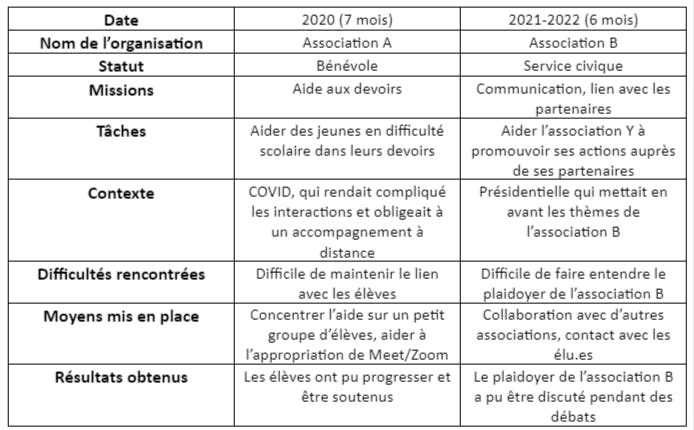How to make a CV for a professional retraining in the impact?
CV and cover letter: the first step in the recruitment process
A good CV (Curriculum vitae) is, and remains, with the cover letter an important step to get a job interview and find a job, an internship, a civic service or a work-study program. During CV writing, the same anxieties often come up: do I have enough work experience? Did I effectively showcase my personality, skills, and accomplishments to respond to the offer? Is this salmon pink background with a photo of me in costume really suitable? (No to the last question)
You may have already seen examples of CVs on the Internet, more or less original, followed training courses or benefited from advice from teachers, relatives or professionals. Rather than giving you advice that you have already read or heard a thousand times to make a professional CV, I suggest that you focus on what an impact-focused CV can have that is different, compared to a "classic" resume template.
On this subject, an article by Jobs that makesense concerned the skills, and in particular the soft skills, sought by a recruiter from the ESS (Social and Solidarity Economy). It emerged that there was no single request on the part of recruiters, apart from the interest for the mission, the need to "find in the career of the person actions of commitments on the same thematic than that of the corporate mission. »
For a specific job market, specific rules!

Write a CV that highlights your commitment
On this subject, Animafac has created a very complete portfolio allowing you to take stock of the skills and aptitudes that you have been able to develop through your socio-professional experiences and explaining to you how to highlight them to attract attention and stand out from the crowd when applying. This easy-to-use method is particularly suitable for people at the start of their professional life, but can be used by everyone, especially in the context of professional retraining!
If the list of your commitments is a little vague, you can take stock of your commitment path and your experiences in the SSE with the help of the table on page 9. This census, which offers you to write the list of missions, tasks, context, difficulties encountered, means put in place and results obtained, will give you a general overview of the skills you have been able to develop during your experiences.
Examples of experiences for your resume:

After having made a sort of summary of your experiences, you can use the tables from page 10 to define yourself in relation to the 11 major categories of transversal skills. Do you have good analytical skills? an ability to work in a group? a taste for communication?
For example, going back to the table above, the skills developed in professional experience within association A could be adaptability (you helped to manage an unforeseen situation and proposed new ways of doing things) and the ability to transmit knowledge by demonstrating pedagogy. The experience in association B demonstrates your skills in communication and negotiation, to bring together a coalition of actors and actresses on an advocacy topic. These can be technical or behavioral skills.

The key to a successful CV: finding a red thread
Once these skills have been identified, all you have to do is link these experiences with a common thread, a common thread that has led you from one experience to another. The common thread is a guiding idea that shows the consistency of your career path, which makes the link between your training and experience in relation to the position sought.
This link can be made by a motivation to work on a position that gives meaning to your action, which allows you to have a positive impact. Alternatively, you may be interested in a sector or theme that drives you (education, health, energy, urban planning, integration, finance, etc.) or even in a form of structure that suits you particularly well (association, cooperative, start-up -up, social enterprise, foundation…).
For example: You moved from Association A to Association B through your motivations: you wanted to continue promoting equal opportunities, but doing it this time in the field of advocacy. Or you may have been interested in the theme of education or the associative structure.
It is of course quite possible to have several motivations in your journey, or even to have negative feedback on an experience that pushes you to continue in another direction. All this allows the recruiter to better understand your personality.
For example, you could say that you were missing something on job X or during training Y which prompted you to reorient yourself in another area.

Define your target profession for your CV
Once your common thread and your skills have been defined, all you have to do is take a closer look at the job titles that interest you and the place you want to occupy in the structure in which you want to work: communication officer ? responsible for partnerships? Advocacy Officer? of development ?
Depending on the position and the skills required, it will then be easier for you to build a coherent story about your career, to enrich your professional experiences by highlighting your associative commitments and to explain how your transversal skills can be useful in your new post.
For example, for a communication or partnership officer position, the imaginary person we have been following from the start can both highlight their skills (adaptability, ability to learn, communication, negotiation), illustrate them by concrete experiences and explain the path that led her to apply.

How do you make this information stand out in the different paragraphs of your resume?
After listing your skills and experiences, you still have to highlight them in a very concrete way in your CV. To do this, it is of course necessary to carefully analyze the job offer, asking yourself what elements of your background you could use to demonstrate the interest and uniqueness of your application.
As such, it is important to contextualize and quantify experiences of engagement like your other experiences. How long have you been in a facility? What missions have you been given?
For example: Association B – Advocacy Officer from October 2021 to March 2022
- Support for students in difficulty in the context of COVID
- Computer training for students and parents
In the same way, dedicate a space to the transversal skills that you have been able to acquire, by not hesitating to detail them in the description of your professional career or in a category in its own right, in a clear and concise manner.
For example: Skills
- Adaptability: Handling unforeseen situations, implementing new communication formats
- Communication: Ability to address various actors and actresses to defend a project, writing press kit
Finally, don't forget to include a "CV hook", a sentence that takes up your red thread, your motivations and your experiences to explain how you came to apply and how your professional project is coherent.
For example: Sensitized since my experience in Association A to the issue of education, I would like to take on the position of [job title], to defend a fairer educational model. Through my associative experience and my civic service, I was able to develop my adaptability and my ability to communicate, as well as an appetite for negotiation.
There you go, we hope that this method will allow you to create and succeed in your CV!
One last tip to put the odds on your side: don't forget to have your CV proofread to avoid spelling mistakes! Also think about taking care of the layout, the graphics and choosing a readable and impactful typography.
Once you have your CV and cover letter, you are ready for your job search in a job with a positive impact!
And if you don't find the ideal job, but you have found your perfect company, also think about the spontaneous application!
👉Training in the professions of ecological and social transition
More about Animafac
👉 Discover Pro'Pulse program by Animafac
For further
👉16 steps for your professional transition
👉 There is no age to start: make a professional retraining at 35, 40, 50
👉How to make a professional retraining when you are on long-term-contract ?
